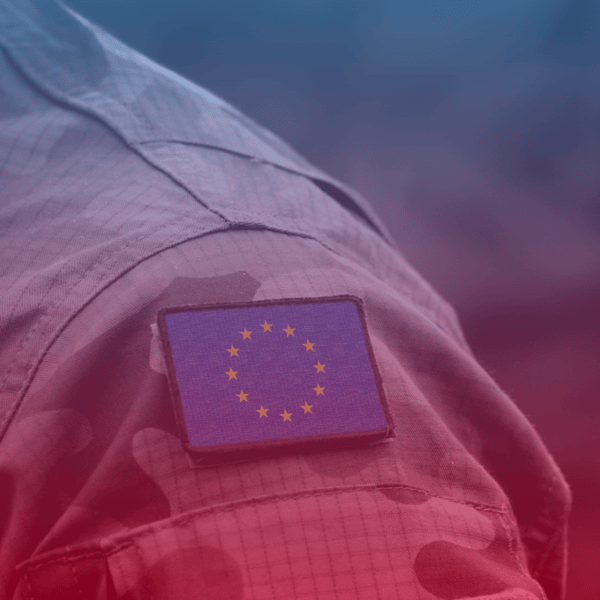
Written by: Nikita Jensen, Researcher for the WG on Security and Defence
Edited by: Lucia Duque Teva
This paper explores whether the European Union (EU) can build a stronger collective identity through a common defence. While the EU has traditionally been fragmented in foreign and security affairs, recent external threats, particularly Russia’s invasion of Ukraine, have prompted greater cooperation. Initiatives like the Security Action for Europe (SAFE), which seeks to boost the EU’s defence industry and coordination, reflect this shift.
The analysis draws on neofunctionalist and new intergovernmentalist theories to examine the tension between supranational integration and member state control. Although there is growing alignment on issues such as support for Ukraine, differences in strategic priorities and commitment levels persist. SAFE highlights both the ambition of the European Commission to assume a more active role in defence policy as well as the potential challenges this creates in terms of democratic legitimacy and unequal outcomes among Member States.
The paper argues that defence integration must be led by member states. Enhanced cooperation offers a practical route forward, allowing willing countries to progress without widening internal divisions. A lasting European defence identity will depend on inclusive, transparent, and accountable processes that reflect both shared goals and political diversity.
Introduction
Since the beginning of the decade, the EU has faced a series of geopolitical challenges. From the Covid-19 pandemic to Russia’s invasion of Ukraine, and in anticipation of potential changes in transatlantic relations, the EU has had to respond to an increasingly unstable international environment. These events have exposed internal pressures and renewed focus on the issue of unity, particularly in the areas of foreign and defence policy.
Traditionally regarded as a “soft power,” the EU has historically refrained from military assertiveness, instead favouring diplomacy, economic cooperation, and the promotion of normative values. However, recent global developments have prompted a reconsideration of this position. The urgency of external threats has brought new attention to the idea of a common defence and the potential for a shared strategic identity. Yet, this growing need for unity has revealed persistent internal divisions. For example, Hungary and Slovakia have blocked consensus on key issues, while France and Germany have taken different positions at critical moments. The balance of power between European Commission initiatives and member state sovereignty also remains a contested issue, and the idea of a single European Army seems impossible given the divisions over who would command it.
This paper explores whether and how a collective European unity could be developed through increased defence cooperation. It draws on competing theoretical perspectives, including neofunctionalism and new intergovernmentalism, to assess both the limitations and the opportunities for deeper integration in this field. By tracing the historical development of EU foreign and security policy, analysing recent initiatives such as the Security Action for Europe (SAFE) and examining current institutional strategies, the paper argues that a sustainable defence identity must be rooted in member-state consensus rather than driven by supranational actors.
Literature Review and Theoretical Framework
The debate over the EU’s ability to integrate foreign and security policy is shaped by competing theoretical perspectives. Neofunctionalism, originally developed by Ernst Haas and further elaborated by later scholars, argues that integration in one area, such as the economy, creates “functional spillover” into others, including defence and foreign policy (Niemann, 2018). In this view, institutions like the European Commission play a central role by initiating and managing integration processes that extend beyond their original scope. Neofunctionalists emphasise the importance of path dependency and the logic of efficiency as key drivers of deeper cooperation.
However, the limitations of neofunctionalism in explaining developments in security and defence have become increasingly clear. Defence remains strongly linked to national sovereignty, historical experience, and identity. In contrast to areas like trade policy, defence involves existential questions of threat perception and national self-understanding, which differ widely among member states. As a result, the Commission’s capacity to promote spillover in this area is constrained, and excessive efforts to do so may lead to political resistance.
This limitation has led to the growing influence of new intergovernmentalism, particularly in the period following the Maastricht Treaty. Scholars such as Bickerton, Hodson, and Puetter (2015) argue that in politically sensitive areas like foreign and security policy, integration is directed by member states rather than supranational institutions. National governments remain reluctant to transfer authority and instead prefer to create intergovernmental structures that facilitate cooperation while maintaining state autonomy.
In addition, the concept of the “capability–expectations gap” (Hill, 1993) remains essential for understanding the EU’s foreign policy limitations. The EU often sets ambitious goals in its external action but struggles to deliver concrete outcomes due to institutional constraints and the divergent preferences of its member states. Hill’s framework helps explain the recurring gap between the EU’s rhetoric and its performance in the Common Security and Defence Policy (CSDP) and broader foreign policy efforts.
Jørgensen (1997) contributes to this discussion by describing the EU as a “Diplomatic Republic,” highlighting the importance of procedural legitimacy and collective decision-making in shaping a shared identity. This interpretation resonates with constructivist perspectives that understand identity as a product of continuous interaction, shared practices, and the internalisation of common norms.
Menon (2011) further examines how institutional design and national preferences shape the development of the CSDP. He argues that the existence of formal institutions is not sufficient; their effectiveness depends on the political will of the member states. This insight underlines the limits of institutionalism in the absence of national commitment. Tonra (2008) adds that EU foreign policy must also be understood in the context of global developments, as external crises often influence internal unity.
Finally, Rieker (2006) provides a useful case study on France, demonstrating how national foreign policies have gradually become “Europeanised.” This process does not imply complete convergence but rather reflects a progressive adaptation to EU-level frameworks. Her findings support the broader claim that a collective identity in EU foreign and security policy is not imposed from above but is constructed through ongoing institutional interaction and shared policy experiences.
Historical Background of the CSDP
The formation of the EU is closely linked to the aftermath of the Second World War and the ambition to secure lasting peace in Europe. Although initial integration focused on economic cooperation, it was politically motivated. The goal was to bind European states, particularly France and Germany, in a way that would make future conflict materially impossible (Deighton, 2002). This vision was first realised in the 1951 Treaty of Paris, which established the European Coal and Steel Community (ECSC) and, later on, in the 1957 Treaties of Rome, which created the European Economic Community (EEC). Security and defence, however, were deliberately excluded from early integration efforts.
Attempts to create a European Defence Community (EDC) in the 1950s ultimately failed, mainly due to French concerns regarding sovereignty and the prospect of German rearmament (Deighton, 2002). A significant divide also emerged between France’s preference for strategic autonomy and the transatlantic orientation favoured by countries such as the United Kingdom. President Charles de Gaulle criticised efforts like European Political Cooperation (EPC), fearing they could undermine France’s vision of an independent European voice. In contrast, the UK and other member states prioritised a “Transatlanticist” view of a strong alignment with the United States through NATO.
As a result, European integration initially focused on economic development, following the assumption that cooperation in “low politics” would eventually spill over into “high politics,” including foreign and defence policy (Tonra, 2008). By the 1970s, EPC had been established as a formal, though intergovernmental, framework for foreign policy coordination. As Hurd (1981) notes, EPC aimed to build consensus among member states while preserving national sovereignty. This institutional arrangement reflected the broader tension between collective ambition and state-led governance.
In the following years, transatlantic preferences dominated. Many EPC discussions were kept informal to avoid attracting criticism from the United States or jeopardising NATO unity. This cautious approach illustrated the sensitivity of security cooperation in a context where American support remained central to European defence planning.
The end of the Cold War marked a turning point. The 1992 Maastricht Treaty established the Common Foreign and Security Policy (CFSP), laying the foundation for closer political and security cooperation. However, as Major (2005) notes, CFSP remained strictly intergovernmental, with decision-making requiring unanimity. This structural constraint has continued to limit the EU’s ability to act effectively on the global stage (Hill, 1993). For instance, although the EU created a multinational battle group in 2005 with contributions from all member states, it has never been deployed, as unanimous approval is needed for any operation. Considering the small scale of the battle group, the prospect of a single European Army seems to be almost impossible if the command structure should include unanimity.
The EU’s failure to respond coherently to the Balkan crises of the 1990s prompted the development of the Common Security and Defence Policy (CSDP) in 1999. This initiative aimed to equip the Union with both civilian and military capabilities for conflict prevention and crisis management (Merlingen, 2012). Nevertheless, core divisions persist. While the EU has achieved high levels of economic integration through supranational mechanisms such as qualified majority voting, foreign and defence policy remain governed by intergovernmental procedures. The requirement for unanimity continues to delay action and reinforces the “capabilities–expectations gap” identified by Hill (1993).
Constructivist scholars have highlighted the role of shared norms and practices in shaping collective identity. Merlingen (2012) describes the development of a “Diplomatic Republic of Europe,” where states gradually adopt a collective logic through diplomatic and operational cooperation under the CSDP. While this process has contributed to some degree of Europeanisation, foreign and defence policy largely remain under national control. This is evident in issues such as the EU’s position on Palestine, where member states like Ireland and Spain differ strongly from Germany. Similarly, migration, when framed as a security concern, often overrides EU unity, as shown by Germany’s reintroduction of border controls. Nonetheless, it is clear that in the past decade, rising external threats have pushed the EU toward greater cohesion in the areas of security and defence. Although challenges remain, these developments suggest a growing willingness among member states to move beyond symbolic cooperation and towards more coordinated action in response to shared risks.
Defence Cooperation Today
Although the divide between Gaullist and Transatlanticist approaches is less stark today, it still influences EU security policy. France continues to support greater European strategic autonomy and backs initiatives like SAFE. In contrast, countries such as Poland and the Baltic states prefer to rely on NATO and the United States for their security. Their geographic proximity to Russia reinforces this preference. While some of these states are re-evaluating their stance due to uncertainties in U.S. foreign policy, trust in transatlantic guarantees remains uneven.
Even where general agreement exists, such as support for Ukraine, obstacles remain. Hungary and Slovakia have repeatedly blocked sanctions and aid packages. Their actions have revived debates about using Article 7 of the Treaty on the European Union, which allows the suspension of rights for member states that breach EU fundamental values in a serious and persistent way (Zsiros, 2025). German Chancellor Merz has called for its application, but France and others have not taken a clear position, and no strong alignment has emerged.
Divisions are also evident in the European Union’s response to the Israel-Palestine conflict. Ireland and Spain have consistently advocated for strong condemnation of Israel’s military actions and have called for concrete measures, including economic and diplomatic consequences. In contrast, Germany has taken a more cautious position, often citing its historical responsibility toward Israel as a factor shaping its foreign policy approach. These differing positions came into sharper focus when the Netherlands led a push to review the EU-Israel Association Agreement, which governs trade and cooperation between the EU and Israel (Euronews, 2025). While a majority of EU foreign ministers eventually supported the review, Germany and 8 others initially resisted the proposal. This episode underscores the persistent difficulty of forming a unified EU stance on international issues, particularly when historical and geopolitical realities vary widely across member states.
When it comes to joint procurement in Defence, Russia’s war in Ukraine has made the need for coordinated security responses within the EU more urgent. In response, the EU has launched several joint initiatives. One of the most significant is the Strategic Compass, adopted in 2022, which outlines a roadmap to strengthen the EU’s security and crisis-response capacities. Its development involved consultations with member states and working groups. This process highlights the continued importance of intergovernmental coordination in defence.
The European Defence Fund (EDF) also reflects this. Established in 2021, the EDF aims to strengthen the EU’s defence technological and industrial base by financing collaborative research and capability development projects. Rather than serving as a general pool of funds for national defence spending, the EDF requires participation from at least three companies or entities based in three different member states (European Commission, 2023). This structure is designed to promote cross-border cooperation and reduce fragmentation within the European defence market. However, while the fund facilitates cooperation, it also preserves member state control by leaving final procurement decisions in national hands. In this way, the EDF reflects the broader tension in EU defence policy between supranational coordination and intergovernmental sovereignty (Mejino-López and Wolff, 2024).
The latest Defence related programme, the Security Action for Europe (SAFE) initiative, was introduced to address industrial gaps and reduce reliance on external partners. It proposes a €100 billion to €150 billion framework aimed at centralising defence procurement and scaling up production capacities across the Union. The SAFE plan is a response to a collective underinvestment in European defence capabilities, especially in light of the war in Ukraine and the realisation that Europe can no longer rely solely on the United States for strategic protection (Beetsma et al., 2025). The initiative frames defence readiness as a European public good, arguing that greater EU-level coordination can create economies of scale and reduce duplication across national systems.
However, this approach has raised concerns. By classifying defence as an industrial policy matter, SAFE operates under qualified majority voting rather than unanimity, thereby circumventing the usual constraints associated with the CFSP. Although legally grounded in the Treaty on the Functioning of the European Union (TFEU), this approach has been criticised as institutional overreach. Smaller member states contend that the initiative may primarily benefit dominant defence industries in countries such as France and Germany while reducing democratic oversight. A key risk is that, without proper safeguards, the initiative could entrench structural inequalities to ensure fair participation across the Union (Beetsma et al., 2025).
The initiative’s rapid rollout by the Commission and its bypassing of the Parliament has also contributed to broader concerns about technocratic decision-making (Cohen and Ionta, 2025). These reactions underscore the political risks of Commission-led efforts in sensitive areas like defence and highlight the need for more inclusive and transparent governance mechanisms.
A Way Forward?
The SAFE initiative and related developments highlight both the growing need for stronger European defence cooperation and the limitations of current strategies. Using economic frameworks to advance defence integration may deliver short-term results, but it lacks the democratic depth needed for long-term unity. Relying on the European Commission to lead this process risks pushing away member states that are already sceptical about Brussels’ authority.
Article 7 of the Treaty on European Union, although legally applicable, remains politically sensitive. It is often seen as a punitive tool and may deepen divisions, particularly among countries that feel excluded or unfairly targeted.
A more constructive alternative is the mechanism of enhanced cooperation (Article 20 TFEU), which allows at least nine member states to move ahead with a project without requiring full participation from the entire Union (EUR-Lex, n.d.). Applying this model to the field of defence could enhance the EU’s ability to respond to crises while still respecting national sovereignty. Member states that are willing to cooperate more closely can move ahead and demonstrate the practical benefits of deeper integration.
Over time, others may be encouraged to join as they observe advantages such as increased strategic influence, improved operational capacity, and better access to shared resources. Furthermore, this flexible approach could also facilitate cooperation with militarily capable non-EU partners such as the United Kingdom and Norway. By avoiding rigid and overly bureaucratic frameworks, the EU would be better positioned to build pragmatic partnerships, both within and beyond its borders, without compromising the autonomy of its members. In the long term, a stable and legitimate European defence identity will depend on bottom-up engagement. Lasting unity in defence can only be achieved through a participatory approach that balances strategic imperatives with democratic legitimacy.
Conclusion
The EU has evolved significantly since its post-war origins centred on economic prosperity and cooperation. However, defence integration remains one of its most complex and contested challenges. As this paper has shown, while recent security threats have created momentum for greater cohesion, structural and ideological divisions continue to hinder progress. Member states remain split on key foreign policy issues, including their positions on Israel, their approach to sanctions, and their support for deeper institutional integration. These divisions are further complicated by concerns about Commission overreach and the centralisation of sensitive decision-making.
The SAFE initiative illustrates both the achievements and limitations of current defence cooperation. It represents a clear step toward strategic autonomy, yet it also bypasses traditional political safeguards. By framing defence as an economic matter, SAFE raises questions about democratic legitimacy and fair distribution of benefits. While such strategies may increase efficiency in the short term, they risk excluding more sceptical states and weakening trust in EU institutions.
Rather than relying on coercive tools such as Article 7 to enforce alignment, the EU should focus on encouraging voluntary cooperation. Mechanisms like enhanced cooperation provide a more politically viable solution. This approach reflects the EU’s foundational principles of consensus and gradual progress.
This paper concludes that a common European defence identity must be developed slowly and inclusively. It will not emerge through centralisation alone, but through long-term engagement and mutual trust. Only by grounding defence cooperation in democratic legitimacy and intergovernmental consensus can the EU build a resilient and unified defence posture capable of responding to future crises.
References
Andersson, J. and Britz, M. (2025). Defence industrial integration and strategic autonomy in the EU. European Security Review, 29(1), pp. 56–74.
Beetsma, R., Buti, M., & Nicoli, F. (2025, March 18). The problem of missing European public goods from the ReArm Europe plan. Bruegel. https://www.bruegel.org/first-glance/problem-missing-european-public-goods-rearm-europe-plan
Bickerton, C. J., Hodson, D., and Puetter, U. (2015). The New Intergovernmentalism: States and Supranational Actors in the Post-Maastricht Era. Oxford: Oxford University Press.
Cohen, C., and Ionta, N. (2025, May 27). EU’s SAFE joint defence lending programme wins final Council approval. Euractiv. https://www.euractiv.com/section/defence/news/eus-safe-joint-defence-lending-programme-wins-final-council-approval/ [Accessed 30 May 2025)
Deighton, A. (2002). The European Security and Defence Policy. Journal of Common Market Studies, 40(4), pp.719–741.
European Commission. (2023). European Defence Fund (EDF). https://defence-industry-space.ec.europa.eu/eu-defence-industry/european-defence-fund-edf_en [Accessed 30 May 2025].
Euronews. (2025, May 21). Israel ‘completely rejects’ EU decision to review trade and cooperation deal. https://www.euronews.com/2025/05/21/israel-completely-rejects-eu-decision-to-review-trade-and-cooperation-deal
Fiott, D. (2023). The Strategic Compass and the Future of European Defence. Brussels: EU Institute for Security Studies.
Hill, C. (1993). The Capability–Expectations Gap, or Conceptualizing Europe’s International Role. Journal of Common Market Studies, 31(3), pp. 305–328.
Hurd, D. (1981). EPC: The European Political Cooperation. The World Today, 37(4), pp.139–147.
Jørgensen, K. E. (1997). PoCo: The Diplomatic Republic of Europe. In K. E. Jørgensen (Ed.), Reflective Approaches to European Governance (pp. 57–75). London: Macmillan.
Major, C. (2005). EU–UN cooperation in military crisis management: the experience of the Artemis operation. European Security, 14(3), pp.353–370.
Mejino-Lopez, J. and G. Wolff (2024, 20 November) ‘A European defence industrial strategy in a hostile world’, Policy Brief 29/2024, Bruegel. https://www.bruegel.org/policy-brief/european-defence-industrial-strategy-hostile-world
Menon, A. (2011). European Defence Policy from Lisbon to Libya. International Affairs, 87(2), pp. 317–331.
Merlingen, M. (2012). EU Security Policy: A Framework for Analysis. London: Routledge.
Niemann, A. (2018). Neofunctionalism Revisited: Integration Theory and the European Union. In Cini, M. and Pérez-Solórzano Borragán, N. (Eds.), European Union Politics. Oxford: Oxford University Press, pp. 69–83.
Rieker, P. (2006). From Common Defence to Comprehensive Security: Towards the Europeanization of French Foreign and Security Policy? Security Dialogue, 37(4), pp. 509–528.
Sabatino, E. (2022). The European Defence Fund: A Step Towards a Single Market for Defence? European Security, 31(2), pp. 188–208.
Tonra, B. (2008). Global Citizen and European Republic: Irish Foreign Policy in Transition. Manchester: Manchester University Press.
EUR-Lex. (n.d.). Enhanced cooperation. https://eur-lex.europa.eu/legal-content/EN/TXT/?uri=LEGISSUM:enhanced_cooperation [Accessed 30 May 2025].Zsiros, S. (2025, May 26). No majority among EU countries to sanction Hungary over rule of law. Euronews. https://www.euronews.com/my-europe/2025/05/26/no-majority-among-eu-countries-to-sanction-hungary-over-rule-of-law

 The ’Ndrangheta’s Infiltration and Threat to European Institutions
The ’Ndrangheta’s Infiltration and Threat to European Institutions  From Paper to Practice: How Grassroots Norms Undermine Gender Rights in Pakistan
From Paper to Practice: How Grassroots Norms Undermine Gender Rights in Pakistan  Exploited Childhoods: The Role of Global Corporations in Perpetuating and Mitigating Child Labour
Exploited Childhoods: The Role of Global Corporations in Perpetuating and Mitigating Child Labour  Human Rights Challenges in Addressing SLAPPs in Media, NGOs and Journalism in the EU
Human Rights Challenges in Addressing SLAPPs in Media, NGOs and Journalism in the EU 


